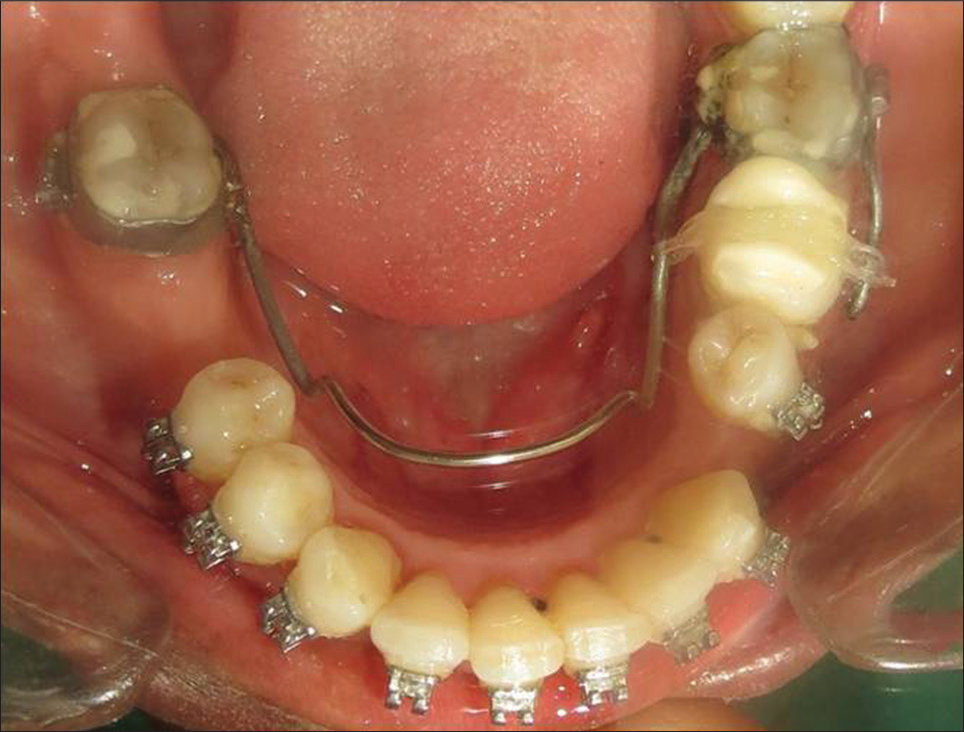Translate this page into:
Mandibular Molar Intrusion with a Modified Lingual Arch
Address for correspondence: Dr. Amit Jaisinghani, Jaisinghani Orthodontic and Dental Clinic, Quater A-9, Sai Chowk, Pimpri, Pune - 411 017, Maharashtra, India. E-mail: orthoamitj@gmail.com
This article was originally published by Wolters Kluwer and was migrated to Scientific Scholar after the change of Publisher.
Abstract
Intrusion of the supra erupted molar is one of the most difficult treatment. Supra eruption is common in a mutilated dentition. This article describes an effective way to bring about intrusion of supra erupted molars.
Keywords
Biomechanics
interdisciplinary
intrusion
Introduction
Intrusion is considered the most difficult type of orthodontic tooth movement. To achieve pure intrusion a bilateral orthodontic force on the over erupted molar would allow the force to be delivered close to the center of resistance.[1-4] The present report describes an effective method of intrusion of mandibular first molar using bilateral orthodontic traction through a modified lingual arch.
Appliance construction and placement
A lingual arch is fabricated from 0.38” stainless steel wire such that it has an inverted v bend near the center of the tooth to be intruded and is soldered to the molar bands. A buccal arm extending forward is made from the same wire soldered to the molar band and an inverted v bend is placed such that it is at the center of the tooth to be intruded [Figure 1]. The inverted v bend on both buccal and lingual side are made so that they prevent slippage of elastomeric chain along the wire. Also, glass ionomer cement bite blocks are placed on the tooth to be intruded to prevent the slippage of the elastomeric chain.

- (a and b) Modified lingual arch made of 0.038” SS wire
Case Report
A 38-year-old female patient reported with proclined and spaced anteriors with multiple missing teeth. The mandibular left first molar had supra-erupted due to loss of opposing tooth.
The mandibular left first molar had supra-erupted by 3 mm with respect to adjacent premolar and molar. The modified lingual arch was placed with bands on lower second molars. Elastomeric chain was stretched from buccal arm along the occlusal surface of molar and from below the lingual arm of the lingual arch was extended back to the buccal arm along the occlusal surface of first molar [Figure 2]. A force of 80 g was applied, and the elastomeric chains were changed every 4 weeks. A significant amount of intrusion of molar was seen in first 2.5 months, and it was complete in 4.5 months [Figure 3]. A comparison of pretreatment and postintrusion lateral cephalogram showed that the mandibular molar had intruded by 2.9 mm (L6 to MP decreased by 2.9 mm). The mandibular second molar tipped distally such that L7 to MP increased by 18°, which resulted in 0.8 mm extrusion of the second molar (L7 to MP increased by 0.8 mm) [Figure 4, 5 and Table 1].

- Modified lingual arch cemented in place

- (a) Pretrearment, (b) 2.5 months after placement of modified lingual arch, (c) posttreatment

- (a and b) Section of pre- and post-treatment orthopantomogram

- Superimposition of pre- and post-treatment lateral cephalogram (pretreatment: black and posttreatment red)
| Pretreatment | After intrusion | Difference | |
|---|---|---|---|
| L6-MP | 30.5 mm | 27.6 mm | 2.9 |
| L7-MP | 25.1 mm | 25.9 mm | −0.8 |
| L6-MP (°) | 94 | 95 | 1 |
| L7-MP (°) | 89 | 107 | 18 |
| Lower anterior facial height | 64.2 | 64.4 | 0.2 |
Discussion
Extrusion of mandibular molars is usually a consequence of loss of antagonistic tooth. Management of extruded molars involves grinding of the crown followed by endodontic treatment and a crown[1] or alveolar osteotomy[2] or corticotomy[3,5,6] of the molar areas and using mini-screw implants as anchorage to intrude the molars. As these techniques are extensive and involve surgical and endodontic intervention, they are generally not well accepted by the patient.
The simple mechanics described in this article relies on the usage of a modification of routinely used lingual arch. As the point of force application is bilateral, it results in pure intrusion of the molars, minimizing the undesirable effects. In this case, while the first molar intruded by 2.9 mm in 4.5 months, the second molar (anchorage) tipped distally by 18° (L7 to MP increased from 89° to 107°) and showed apparent extrusion of 0.8 mm. There was no significant increase in the lower anterior facial height (0.2 mm). Thus, the appliance serves as a noninvasive mode of intruding the molars in interdisciplinary cases where full arch bonding is not feasible.
Financial support and sponsorship
Nil.
Conflicts of interest
There are no conflicts of interest.
References
- Maxillary molar intrusion with the molar intrusion arch. J Clin Orthod. 2000;34:90-3.
- [Google Scholar]
- Intrusion of overerupted upper second molars with a modified lingual arch. J Clin Orthod. 2004;38:622-6.
- [Google Scholar]
- Specific mechanics for abutment uprighting. Aust Dent J. 1980;25:273-8.
- [CrossRef] [PubMed] [Google Scholar]
- Surgical-orthodontic treatment for overerupted maxillary molars. J Clin Orthod. 1985;19:350-1.
- [Google Scholar]
- Intrusion of overerupted molars by corticotomy and magnets. Am J Orthod. 2001;120:209-16.
- [CrossRef] [PubMed] [Google Scholar]






